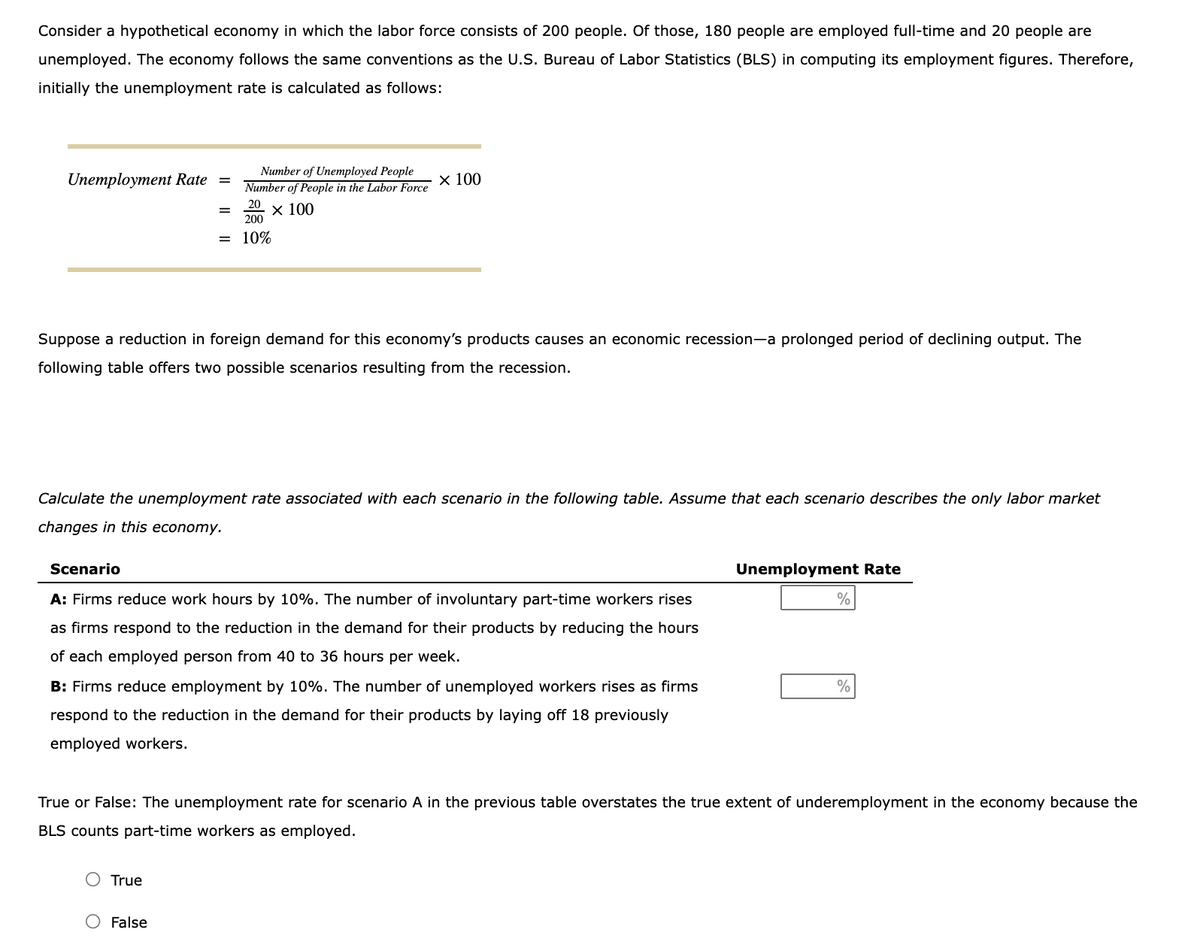Consider a hypothetical economy in which the labor force consists of 200 people. Of those, 180 people are employed full-time and 20 people are unemployed. The economy follows the same conventions as the U.S. Bureau of Labor Statistics (BLS) in computing its employment figures. Therefore, initially the unemployment rate is calculated as follows: Unemployment Rate = Number of Unemployed People Number of People in the Labor Force x 100 20 x 100 %3D 200 = 10% Suppose a reduction in foreign demand for this economy's products causes an economic recession-a prolonged period of declining output. The following table offers two possible scenarios resulting from the recession.
Consider a hypothetical economy in which the labor force consists of 200 people. Of those, 180 people are employed full-time and 20 people are unemployed. The economy follows the same conventions as the U.S. Bureau of Labor Statistics (BLS) in computing its employment figures. Therefore, initially the unemployment rate is calculated as follows: Unemployment Rate = Number of Unemployed People Number of People in the Labor Force x 100 20 x 100 %3D 200 = 10% Suppose a reduction in foreign demand for this economy's products causes an economic recession-a prolonged period of declining output. The following table offers two possible scenarios resulting from the recession.
Chapter27: The Philips Curve And Expetactions Theory
Section: Chapter Questions
Problem 8SQP
Related questions
Question

Transcribed Image Text:Consider a hypothetical economy in which the labor force consists of 200 people. Of those, 180 people are employed full-time and 20 people are
unemployed. The economy follows the same conventions as the U.S. Bureau of Labor Statistics (BLS) in computing its employment figures. Therefore,
initially the unemployment rate is calculated as follows:
Unemployment Rate
Number of Unemployed People
Number of People in the Labor Force
х 100
20
х 100
200
= 10%
Suppose a reduction in foreign demand for this economy's products causes an economic recession-a prolonged period of declining output. The
following table offers two possible scenarios resulting from the recession.
Calculate the unemployment rate associated with each scenario in the following table. Assume that each scenario describes the only labor market
changes in this economy.
Scenario
Unemployment Rate
A: Firms reduce work hours by 10%. The number of involuntary part-time workers rises
%
as firms respond to the reduction in the demand for their products by reducing the hours
of each employed person from 40 to 36 hours per week.
B: Firms reduce employment by 10%. The number of unemployed workers rises as firms
respond to the reduction in the demand for their products by laying off 18 previously
employed workers.
True or False: The unemployment rate for scenario A in the previous table overstates the true extent of underemployment in the economy because the
BLS counts part-time workers as employed.
O True
False
I|||
Expert Solution
This question has been solved!
Explore an expertly crafted, step-by-step solution for a thorough understanding of key concepts.
This is a popular solution!
Trending now
This is a popular solution!
Step by step
Solved in 2 steps

Recommended textbooks for you







Macroeconomics: Private and Public Choice (MindTa…
Economics
ISBN:
9781305506756
Author:
James D. Gwartney, Richard L. Stroup, Russell S. Sobel, David A. Macpherson
Publisher:
Cengage Learning

Economics: Private and Public Choice (MindTap Cou…
Economics
ISBN:
9781305506725
Author:
James D. Gwartney, Richard L. Stroup, Russell S. Sobel, David A. Macpherson
Publisher:
Cengage Learning
